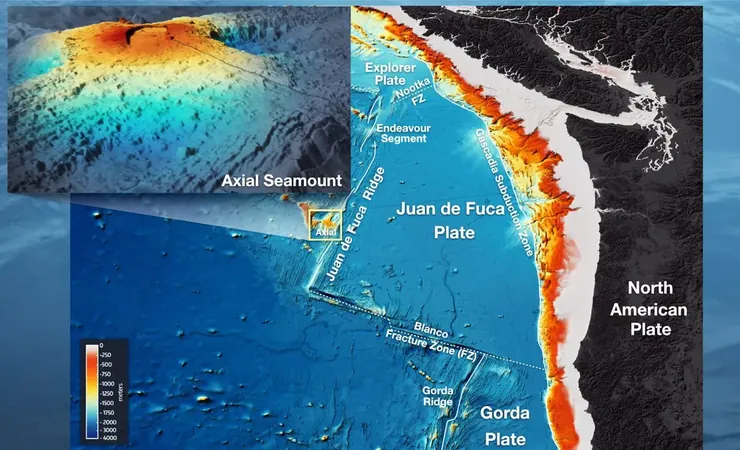
Underwater Volcano Off Oregon Coast Poised for Eruption: What You Need to Know Before 2025!
2025-01-02
Author: Wai
Underwater Volcano Off Oregon Coast Poised for Eruption: What You Need to Know Before 2025!
In a dramatic turn of events beneath the waves of the Pacific Ocean, 470 kilometers off the coast of Oregon, Axial Seamount—a premier underwater volcano—is showing signs of imminent eruption. Experts predict that this geologic powerhouse may erupt before the end of 2025, thanks to years of rigorous monitoring and a recognizable volcanic cycle.
Bill Chadwick, a prominent geophysicist at Oregon State University, describes the situation akin to a high-pressure cooker nearing its boiling point. “Based on current trends and the assumption that Axial is gearing up to erupt as it approaches the 2015 inflation threshold, our anticipated eruption window spans from now until late 2025,” Chadwick explained at the recent American Geophysical Union meeting.
The Art and Science of Eruption Prediction
Predicting volcanic eruptions is notoriously difficult, often providing little more than hours of notice. However, Axial Seamount stands out as an exception. Nestled on the Juan de Fuca Ridge, this underwater titan has erupted with notable regularity, as evidenced by its past eruptions in 1998, 2011, and 2015. Researchers observed that as magma accumulates, the seafloor swells, seismic activity intensifies, and the volcano ultimately erupts.
Recently, scientists recorded a concerning doubling of the volcano's inflation rate, coupled with seismic activity escalating to over 500 earthquakes per day by mid-2024. “It can’t sustain this pressure indefinitely,” Chadwick warned, indicating that an eruption may be imminent.
Mark Zumberge from the Scripps Institution of Oceanography underscored the advanced monitoring capabilities at Axial. “It’s the most well-instrumented submarine volcano in the world,” he stated. The extensive network includes seafloor pressure sensors and autonomous underwater vehicles (AUVs), providing critical data on volcanic behavior.
New studies have employed cutting-edge seismic techniques like full waveform inversion (FWI), enabling scientists to create high-resolution images of Axial's magma reservoirs. The results spotlight a major magma pocket beneath the summit with melt fractions reaching up to 37%—a level that signals impending mobilization.
Why Axial Seamount Matters
While underwater volcanic eruptions typically pose no immediate threat to human life, they can have far-reaching effects on marine ecosystems and even catalyze tsunamis. For instance, the 2022 Hunga Tonga eruption inflicted approximately $90 million in damages, emphasizing the need to understand volcanic impacts more thoroughly.
Researchers are keen on capturing Axial's forthcoming eruption in real-time. Rebecca Carey, a volcanologist at the University of Tasmania, views this as a potentially groundbreaking opportunity. “Observing the eruption will offer valuable insights into its effects on hydrothermal systems and nearby biological communities,” she noted.
Every eruption potentially refines predictive models, with artificial intelligence now being harnessed to analyze seismic data patterns, aiming to forecast eruptions with unprecedented precision—potentially down to the hour. “Will this new technology effectively detect precursory earthquakes?” Chadwick pondered. A successful answer could revolutionize volcanic monitoring globally.
The findings from Axial have crucial implications beyond its immediate region. Situated at the fusion of the Juan de Fuca Ridge and the Cobb Hotspot, the active magma supply here plays a significant role in the formation of oceanic crust. Research illustrates how magma accumulates, pools, and eventually escapes, contributing seminally to geological processes.
An Opportunity for Future Insights
The looming eruption of Axial Seamount serves as a significant learning opportunity for volcanology. The 2015 eruption, which expelled a staggering 156 million cubic meters of lava, unveiled vital information about volcanic activity and seafloor formation processes, guiding current monitoring efforts.
However, experts urge caution. “There’s always the possibility that a volcano could follow an unforeseen pattern and behave unpredictably,” cautioned Michael Poland from the U.S. Geological Survey. Striving to translate observed patterns into broader principles remains a scientific challenge.
Axial Seamount offers a unique case study. Whatever unfolds in 2025, the knowledge gained from this underwater volcano will extend beyond its submerged depths, enhancing our understanding of the dynamic processes that shape our planet. As the world watches, scientists are determined to decode the secrets held by Axial, one tremor at a time. Stay tuned for more dramatic updates from the deep!




 Brasil (PT)
Brasil (PT)
 Canada (EN)
Canada (EN)
 Chile (ES)
Chile (ES)
 Česko (CS)
Česko (CS)
 대한민국 (KO)
대한민국 (KO)
 España (ES)
España (ES)
 France (FR)
France (FR)
 Hong Kong (EN)
Hong Kong (EN)
 Italia (IT)
Italia (IT)
 日本 (JA)
日本 (JA)
 Magyarország (HU)
Magyarország (HU)
 Norge (NO)
Norge (NO)
 Polska (PL)
Polska (PL)
 Schweiz (DE)
Schweiz (DE)
 Singapore (EN)
Singapore (EN)
 Sverige (SV)
Sverige (SV)
 Suomi (FI)
Suomi (FI)
 Türkiye (TR)
Türkiye (TR)
 الإمارات العربية المتحدة (AR)
الإمارات العربية المتحدة (AR)